Conservation efforts can slow or reverse declines in biodiversity
We have seen that human activities have caused a decline in the world’s biodiversity. We now look at what can be done to slow or even reverse these declines. Over the long term, we need to stabilize the size of the human population because human activities have caused most species declines during the past several centuries. Over the short term, we need to reduce human-caused sources of mortality and low reproduction in species so that these species can persist long into the future. During the past several decades, scientists have been developing effective strategies to preserve biodiversity, although these approaches are often neither easy nor inexpensive. In this section, we will focus on habitat protection, habitat management, reduced harvest, and species reintroductions.
560
Habitat Protection
Minimum viable population (MVP) The smallest population size of a species that can persist in the face of environmental variation.
Because the largest contributor to the loss of biodiversity is the loss of habitat, one of the major factors in conserving biodiversity has been habitat protection. The goal in protecting a habitat is commonly the preservation of a large enough area to support a minimum viable population (MVP), which is the smallest population size of a species that can persist in the face of environmental variation. The population must also be distributed widely enough to prevent local catastrophes, such as hurricanes and fires, from threatening the entire species. At the same time, some degree of population subdivision may help prevent the spread of disease from one subpopulation to another.
The task of protecting a suitable habitat becomes more complicated when a population’s habitat requirements change with the seasons or when it undertakes large-scale seasonal migrations. In the Serengeti ecosystem of East Africa, for example, patterns of rainfall distribution and plant growth vary seasonally. Huge populations of wildebeests, zebras, and gazelles undertake long-distance seasonal migrations in search of suitable grazing areas. Because migratory populations use the entire area of the Serengeti ecosystem over the course of a year, the preservation of only one section would not meet their needs. For similar reasons, the massive herds of bison, also known as buffalo, can never be fully restored to North American prairies because their seasonal migration routes are now blocked by miles of fencing and agricultural fields. Bison survive in a few small reserves in the American West—most notably in the Greater Yellowstone Ecosystem—but most of the lands they once occupied can never be recovered.
This Greater Yellowstone Ecosystem, an 80,000-km2 area that is centered on Yellowstone National Park in Wyoming, is one of the best-known examples of preserving a large collection of habitat and includes federal, state, and private lands from three states, as illustrated in Figure 23.22. The management plan for the Greater Yellowstone Ecosystem seeks to maintain the region in a natural, self-sustaining condition. Natural forest fires should be allowed to burn, as they did in 1988 over half of Yellowstone National Park, and top predators, such as the grizzly bear and gray wolf, should be restored. As we will see in “Ecology Today,” these top predators provide natural controls over populations of large grazers, and controlling the populations of top grazers has far-reaching effects on the ecosystem.
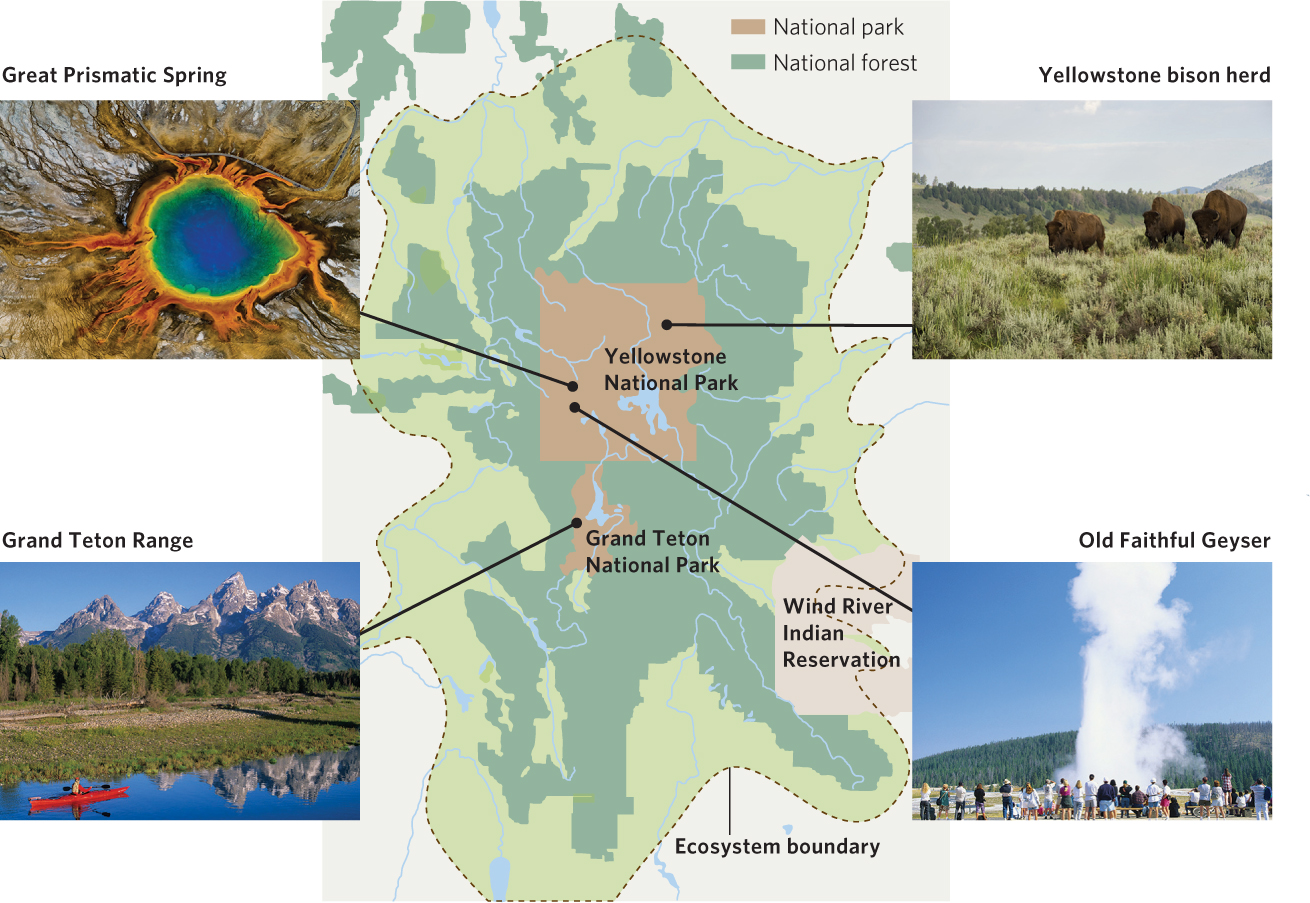
561
The need to preserve habitat is recognized around the world, and many countries are setting aside such areas. The amount of terrestrial habitat that is being protected has continually increased over the past 40 years, as shown in Figure 23.23a. In fact, 57 percent of the world’s countries have protected at least one-tenth of their land. Though the need to protect marine habitats has been recognized much more recently, as you can see in Figure 23.23b, it has also increased over time.
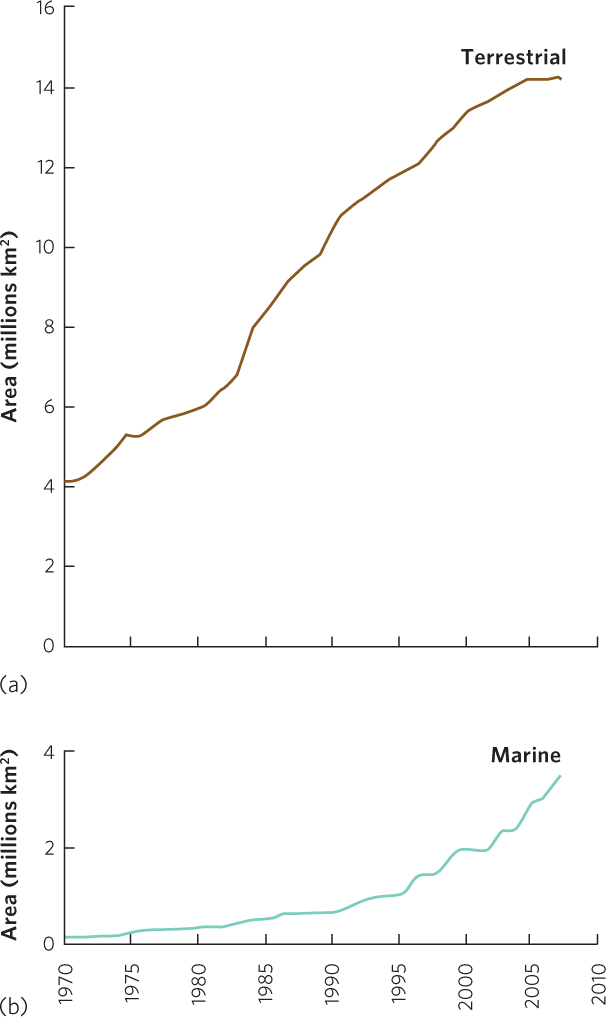
Even when lands are set aside, many countries cannot afford to protect them from squatters and poachers, and often governments allow mining and logging within protected lands. However, involving local people in the design and management of protected areas has been particularly effective since the benefits of conservation, which often include the income generated by ecotourism, become tangible and economically compelling to local people. The most successful efforts typically include large geographic areas, low human densities, a positive public attitude toward the preservation effort, and effective law enforcement to protect species from being poached.
Reduced Harvesting
When overharvesting is identified as a cause of decline in a species, reducing the harvest is an obvious approach to protection. However, this is complicated when it involves people’s livelihoods. For example, we saw that the collapse of the Atlantic cod fishery had a major negative economic impact on the fishing industry that had depended on cod for generations and on the businesses supported by the cod fishing industry. Although some species can take a long time to recover their population size, reducing the harvest of a declining species often leads to a return to abundance. For instance, the northern elephant seal (Mirounga angustirostris) was hunted so much that by the late 1800s it was thought to be extinct (Figure 23.24). Small populations were subsequently discovered in the 1890s and the total population was estimated to be about 100 individuals. In the early 1900s, the seal was given protection by the United States and Mexico. Once protected, the elephant seal population started to rebound rapidly and today there are more than 150,000 individuals, distributed throughout much of the former range of this species in California and Mexico. Similar successes have occurred for the American crocodile (Crocodylus acutus), the whooping crane (Grus americana), and the bald eagle.
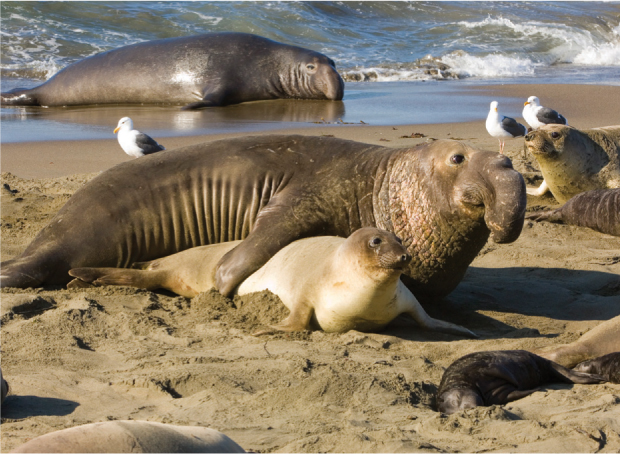
562
Species Reintroductions
Sometimes a species comes so close to extinction that it requires human intervention to bring it back from the brink. We saw an example of this when we discussed the recovery program for the black-footed ferret at the end of Chapter 13. Such efforts can require a great deal of effort and money, and the recovery may take decades.
A classic example of a species reintroduction is the case of the California condor, a large vulture that feeds on dead animals (Figure 23.25). During the latter half of the twentieth century, condor numbers dwindled due to a variety of causes including illegal shooting, illegal collection of eggs from condor nests, consumption of lead bullet fragments from animals the condor scavenged, and consumption by the condor of dead coyotes and rodents that had been poisoned. When the condor population in southern California sank to fewer than 30 individuals in the late 1970s, biologists made the difficult decision to bring the entire population into captivity. From 1982 to 1987, the 22 remaining wild birds were captured and brought to special breeding facilities located at zoos in Los Angeles and San Diego where they were protected from the threats that had taken such a toll in the wild.
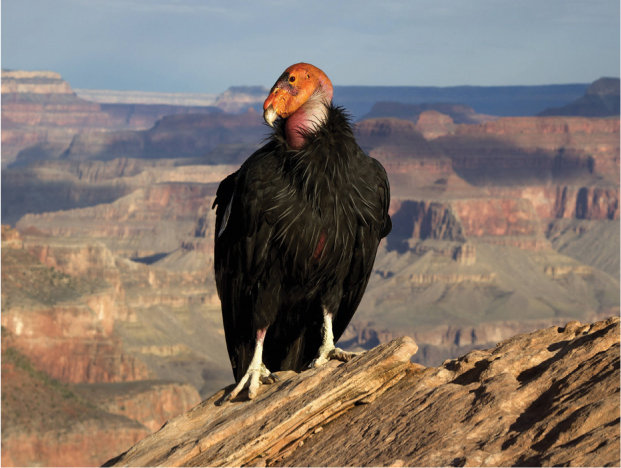
Condors presented an extreme challenge for recovery. Individuals take 6 to 8 years to reach maturity and they typically only lay one egg per year in the wild. However, researchers found that if they removed the single egg, a female would lay another. In fact, a female condor could be tricked into laying up to three eggs per year. Biologists incubated the surplus eggs and reared the birds using puppets to feed the chicks to minimize human contact. As the chicks grew up, they were released back into the wild. At the same time, efforts were made to reduce the threats to the condors. These substantial efforts have paid off; in 2013, there were more than 400 condors alive both in captivity and in the wild following reintroductions into California, Arizona, and Mexico. In addition to increasing the condor population, this high-profile case heightened local residents’ awareness of conservation issues and resulted in the preservation of large tracts of habitat in mountainous regions of southern California. People have also come to understand that restoring the condor population can be compatible with other land uses. Recreation does not have to be banned from condor habitats as long as human access to nesting sites is restricted. Legal hunting doesn’t harm condors as long as steel rather than lead bullets are used. Finally, ranching does not threaten condor populations as long as coyote and rodent control programs are condor-safe.
Species reintroductions can cost millions of dollars and are usually directed toward species that appeal to the public such as black-footed ferrets, condors, and wolves. Some people may question the wisdom of spending millions of dollars to save one species. However, efforts made to save a single species, such as setting aside habitat and reducing the prevalence of poisons, often have positive effects on a large number of species. We will see an excellent example of this in “Ecology Today,” which details the ecosystem effects of reintroducing the gray wolf to Yellowstone National Park.
Throughout this book, we have examined the factors that determine the distribution and abundance of species throughout the world. We have seen that there is an amazing diversity of species on Earth that impresses us with its beauty and plays essential roles in the ecosystems upon which we depend. The decline in the world’s biodiversity is at a critical stage because human activities threaten populations of many species. However, by appreciating the importance of the world’s species and understanding their ecology we can take the steps necessary to slow population declines and species extinctions, and to find ways to coexist.
563
ECOLOGY TODAY CONNECTING THE CONCEPTS
RETURNING WOLVES TO YELLOWSTONE
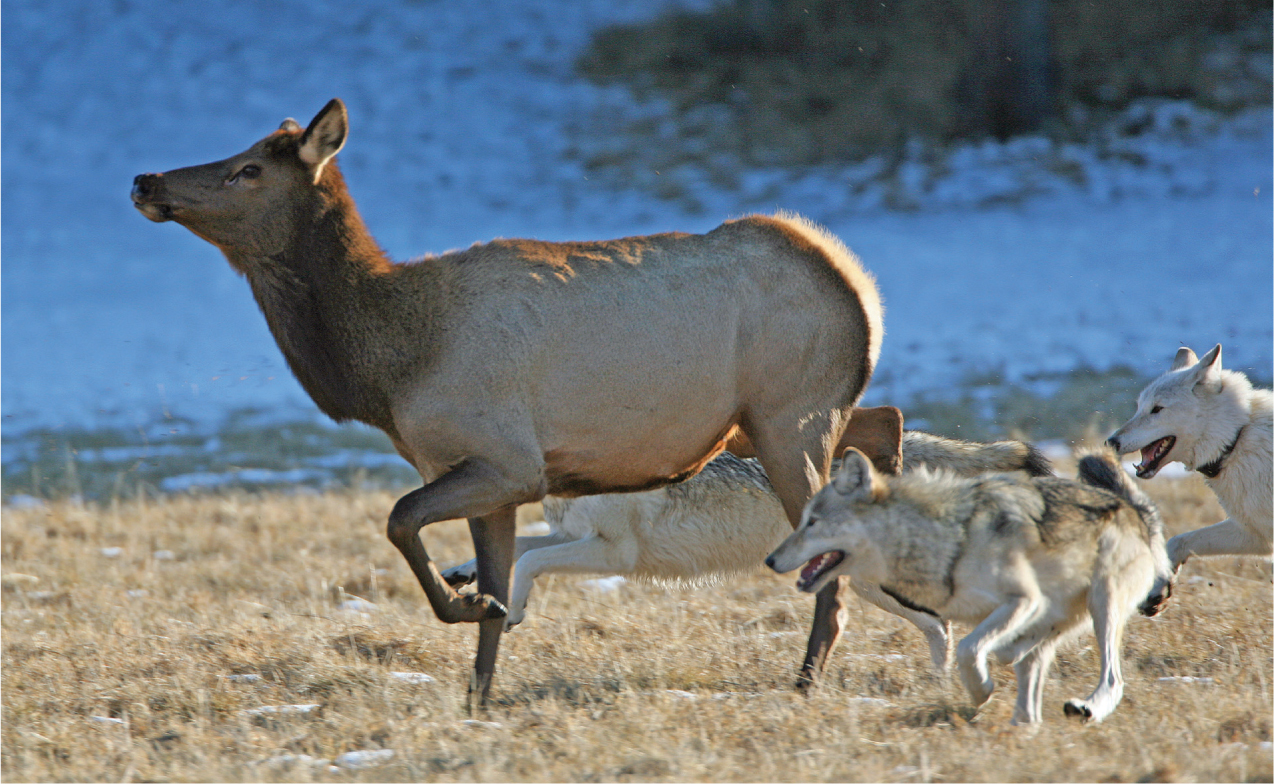
As we have seen in this chapter, restoring biodiversity can be a difficult challenge, and nowhere has this been more apparent than in the attempt to return the gray wolf to the Greater Yellowstone Ecosystem. The challenges in this case include ecological, economic, social, and political factors. After all, not everyone is excited about bringing back a top predator with a reputation for being a bloodthirsty killer.
The gray wolf once roamed throughout most of North America, but fear of wolves and concerns about their preying on livestock led to government programs that eliminated the wolf from nearly all of the United States and southwestern Canada. These programs caused the wolf to be eradicated from all of the lower 48 states except for northern Minnesota by 1925. In the 1940s, Aldo Leopold, a prominent professor of wildlife management, first proposed returning the wolves to Yellowstone National Park. By the 1960s, public attitudes toward wolves started to shift as many people began to see the intrinsic value of restoring ecosystems to a more natural state. In 1973, the Endangered Species Act was passed and it classified gray wolves as an endangered species, which required the development of a plan that would increase their abundance. Because Yellowstone was a large protected area, it was an obvious place for a possible reintroduction.
The plan to reintroduce wolves had supporters and detractors. Public opinion polls found that the general public and the tourists who visited the park favored the idea. However, local hunters worried that the wolves would reduce the populations of large game such as elk. Moreover, the local livestock ranchers worried about their herds because wolves sometimes kill cattle and sheep. For nearly 2 decades, the reintroduction of wolves was debated, studied, and pushed in different directions by politicians representing various constituents. Throughout the early 1990s, the U.S. fish and Wildlife Service held 130 town meetings in the area and received thousands of written comments on a proposed reintroduction plan. They also estimated the impacts of a wolf reintroduction to Yellowstone. Their best estimate was that an eventual population of 100 wolves would kill about 20 cattle, 70 sheep, and 1,200 wild ungulates such as elk, deer, and antelope each year from a population of 95,000 wild ungulates. The economic benefit from increased tourism to the area because of the wolves was estimated at $23 million, which is a substantial instrumental value. After a series of court hearings and repeated judgments in favor of the reintroduction plan, 31 wolves were captured in Canada and released into Yellowstone in 1995 and 1996.
564
Nearly 2 decades later, the effects of the reintroduction have been felt throughout the ecosystem. When the wolves were eradicated in the early 1900s, the elk population rapidly increased and their feeding nearly eliminated aspen and cottonwood trees along rivers. The return of the wolves, and their rapid increase to a population of more than 220 individuals by 2001, reduced the elk population by half and caused the elk to alter their habitat use. Rather than spending much of their time along the rivers and streams during the summer, the elk moved to the higher elevations where the risk of wolf predation was lower. As a result, aspen and cottonwood trees are now thriving. Because these trees are a favorite food of beavers, the increase in aspens and cottonwoods has attracted more beavers into the region, which has led to an increase in beaver dams that form large ponds. In addition, the wolf reintroduction caused a severe reduction in the population of coyotes since they are prey for wolves. This likely had a cascading effect on the many prey species that coyotes consume. The abundant carcasses of elk and other prey of the wolves also benefited populations of scavengers such as ravens and golden eagles, which are once again common in Yellowstone. In short, the reintroduction of the wolf caused the ecosystem to move back to more closely resemble its earlier condition. In 2008, the Yellowstone wolf population was deemed to have recovered well enough to be removed from the federal list of endangered species. The wolves are now hunted in limited numbers and the wolf population has persisted. It will be interesting to see if hunting affects the size of the wolf population and what continued effects the wolves will have on the ecosystem.
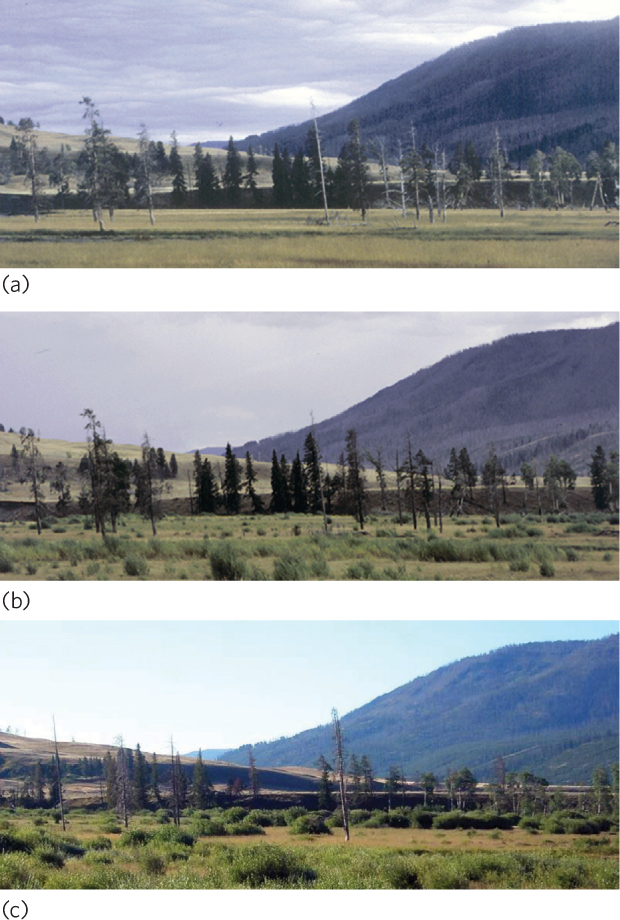
The return of the wolf to the Greater Yellowstone Ecosystem demonstrates that restoring biodiversity is not a simple task. Restoration plans need to consider not only the ecology of the reintroduction but also the social, political, and economic factors. The plans must be evaluated by all interested parties and the process can often take a long time. With patience, however, species and ecosystems can eventually be restored.
SOURCES: Fritts, S. H., et al. 1997. Planning and implementing a reintroduction of wolves to Yellowstone National Park and Central Idaho. Restoration Ecology 5: 7–27.
Ripple, W. J., and r. L. Betscha. 2011. Trophic cascades in Yellowstone: The first 15 years after wolf reintroduction. Biological Conservation 145: 205–213.
Smith, D. W., et al. 2003. Yellowstone after wolves. BioScience 53: 330–340.
565